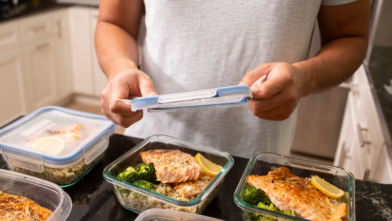Follow these tips the next time you’re shopping for frozen pizzas to make a choice that better supports your diabetes management.
Tips for Buying Frozen Pizzas
1. Check the carb count. Carbohydrates (carbs) impact your blood glucose (blood sugar) the most. The amount of carbs you should eat a day varies from person to person, but when browsing the frozen pizza aisle, check the Nutrition Facts label and take home the pizza with the fewest amount of carbs per serving.
2. Watch the sodium. Frozen pizzas tend to have high amounts of sodium—especially when the pizza has processed meats, like pepperoni and sausage. Compare nutrition labels to find the pizza with the lowest sodium.
3. Find the fats. Some fats are better for you than others. You should pick pizzas that have higher amounts of unsaturated, polyunsaturated, and monounsaturated fats and lower amounts of trans and saturated fats. Like sodium, processed meats are the culprits here too—they tend to have high amounts of the fats you want to avoid.
4. Avoid process meats where you can. In fact, it’s best to minimize the amount of processed meats in frozen pizzas altogether. In addition to high amounts of sodium and fats, processed meats can raise HDL, sometimes called “bad,” cholesterol and increase your risk for heart disease down the road.
5. Veg out! Non-starchy vegetables should take up the most space on your diabetes plate and your frozen pizzas. Compare brands to find the pizza with the most veggies—that includes veggies in the crust as well as the toppings!
6. Look for less sugar. Even though they’re savory, frozen pizzas still contain sugar! Choose the pizza with the lowest amount of sugar you can find.
7. Power-up with protein. Protein in our meals helps us feel full and satisfied for longer while giving us the energy to live our best lives. Look for pizzas that are either labeled an “excellent” or “good” source of protein, meaning they have at least 20 percent or 10–19 percent of your daily value of protein per serving, respectively. Even though processed meats are a source of protein, continue to avoid them where possible.
8. Count the calories. Look for a pizza that has the fewest calories while offering the most nutrients. Also, check the Nutrition Facts label for the portion size and use it as a guide for how many slices you eat.
9. Build your own pizza using premade crust. Many pizza brands sell plain frozen crust, ready for you to add your own sauce, cheese, and toppings. This is an easy and delicious way to control the amount of sodium and saturated fat that’s on your pizza.
10. Serve salad on the side. By adding a side salad, full of fresh leafy greens and vegetables, you’ll add fiber and antioxidants to your meal. Top the salad with an olive oil vinaigrette or avocado slices for heart-healthy fats.
Making the Pizza
Using premade pizza crusts, you can customize recipes to your unique tastes, like how we customized these Avocado Egg Pizza, Pesto Peach Pizza, and Nuts for Pine Nuts Pizza recipes using cauliflower pizza crust.
Talk to Your Health Care Team
Everyone with diabetes has different nutritional needs. Talk to your health care team about the amount of carbs, sodium, fat, and calories you should be eating to meet your goals.
This article is brought to you by CAULIPOWER®.








